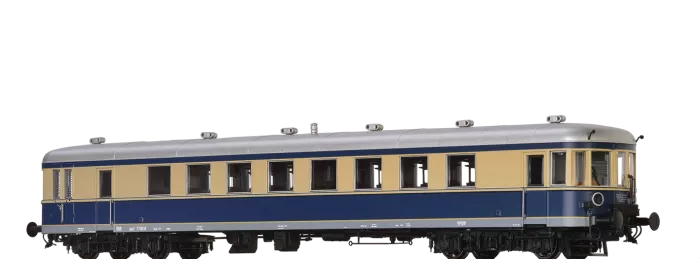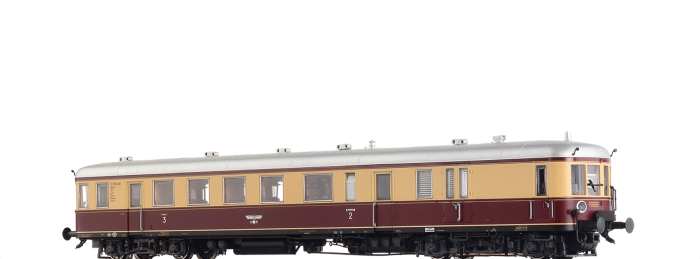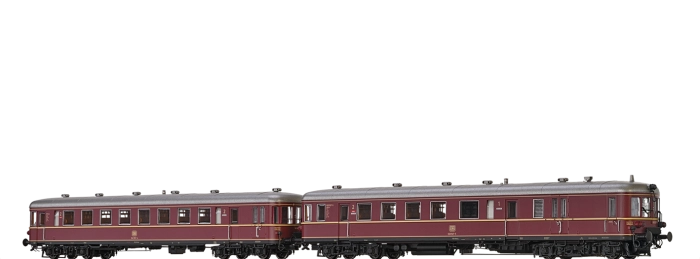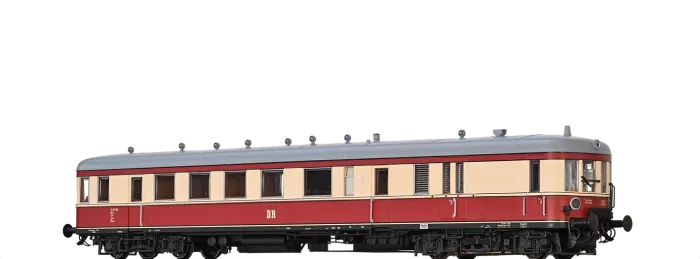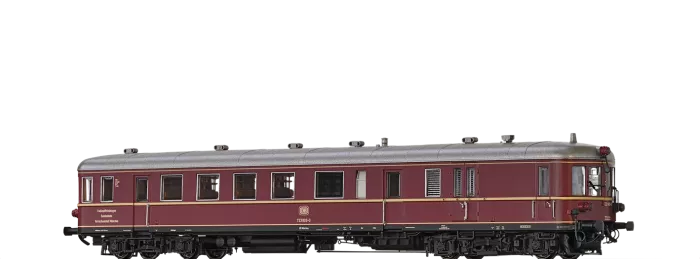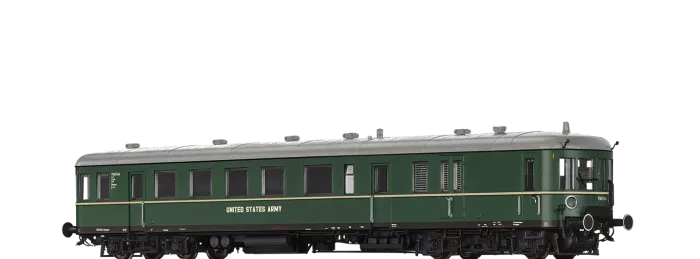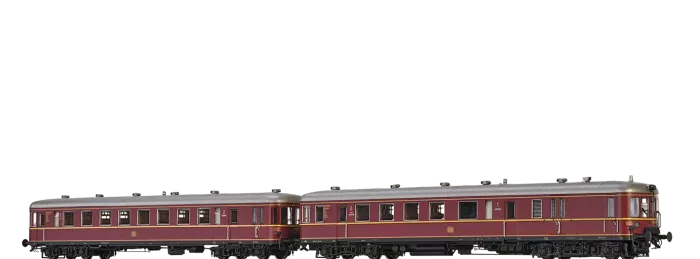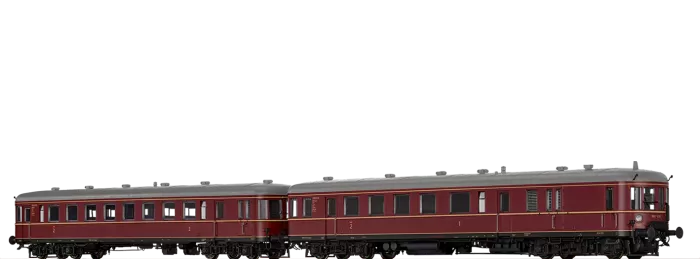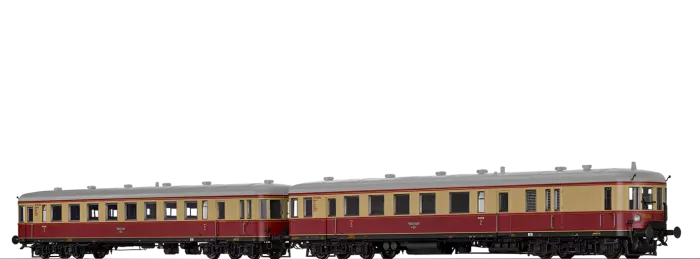
Diesel Railcar BR 660 and Trailer VS945 DB (double unit)
Road no.: 660 516-6 / 945 832-4
Model details
- Drive to two axles
- Extra mounted and free-standing metal handrails and steps
- True-to-epoch lighting
- Finely detailed bogies
- Fine rivets
- Illuminated driver´s cab
- Prepared for sound or with built-in sound
- Metal drive unit
- Interior lighting
- Short coupling kinematics
- Multipart interior fittings
- True to original corrugated wheel disks
Downloads
Info about the original
Going back to a proposed development from the Westwaggon Company who, together with Waggon- und Maschinenfabrik A.G. and Düsseldorfer Waggonfabrik, was responsible for the manufacture of the new VT 137 347 - 366 and 137 377 - 396 secondary railway railcars, the industry launched the last large-scale range of the typically light railcars on to the tracks in 1939 and 1940. Basis for this was the German National Railway (DR) procurement programme from 1936 which, until this point, ensured the continuous further development of railcars. Typically for this era, the striking basket arch shape with the large buffers characterised the front of the vehicle and allowed the staff to move to the adjacent vehicle via a respective passage located on the front sides during the journey. In line with their BCPw4itrvT-36 design designation, they boasted a 2nd class (B) compartment with 6 cushioned seats and a 3rd class (C) compartment, equipped with 43 wooden seats. The vehicles were also equipped with a luggage compartment (Pw) which was located behind the front driver's cab. The GO56 h Maybach engine, that is definitely not as well-isolated as today in terms of noise and heat, also protruded into the driver's cab from underneath and was equipped with an appropriate interior cladding. The power from the 225 HP engine was transferred to the first axle of the front bogie via the Voith transmission and allowed the VT to reach a top speed of 80 km/h. The beige and claret paint coat complete with black cover strips and bright roof clearly followed the paint specifications for vehicle coats of the time. The wartime events, which began in 1939, scuppered the original DR settlement plans. Although the first railcars arrived at Fulda and Heidelberg railway depot as originally planned, the following deliveries were evenly distributed across the Hanover, Cologne and Saarbrücken directorates. Obviously, few railcars were actually handed over for regular service. Instead they were primarily used for military purposes. However, this suddenly changed at the end of the war. After the railcars were assumed by the recently-founded German Federal Railway (DB), several design changes were made in the 1950s in order to retrofit the vehicles that now bore the designation VT60.5 for the upcoming service period. At the Friedrichshafen repair centre, the engines were replaced with 330 HP MAN machines that were already used in small locomotives from service group III. The upholstering of the 3rd class which was upgraded to become 2nd class also increased passenger comfort. Furthermore, many railcars were equipped with modern DB lights during the 1960s in order to improve the view of the track and the conspicuous railcar lights from the National Railway era were removed. Colour changes were also made as the uniform purple for DB diesel vehicles replaced the old DR colour scheme. In contrast to the initial settlement, DB distributed their 31 VT60.5 vehicles to many more operating locations. Consequently, the Rheine, Darmstadt, Stuttgart, Kassel, Frankfurt-Griesheim, Heilbronn, Nuremberg and Friedrichshafen railway depots became primary application locations. In doing so, six railcars were leased to the American occupying forces until 1960. As the vehicles aged, the inventory of the VT60.5 shrunk by the mid-1960s and the Rheine railway depot became the de facto discontinuation railway depot for the remaining railcars of the old design belonging to DB. With a fleet of six vehicles, the inventory was the highest here at the start of the 1970s. Four more vehicles were stationed in Nuremberg and two further vehicles were also in service; one in Heilbronn and one in Kassel. These 12 vehicles, which were issued with the EDP-compliant 660 designation, were all removed from regular service by 1972. Converted to radio measurement wagons, the former 660 506 and 660 531 remained in service until 1979. Only the VT 60 531 exists today. Only three railcars - the 137 348, 137 366 and the 137 387 - remained in the Soviet occupation zone following the war. They were utilised from the Aschersleben railway depot. However, all of the railcars were removed from service by 1969 as a result of the poor availability of replacement parts. Alongside the 40 railcars, the procurement plan also allowed for suitable VS145 control cars, particularly for the VT137 347 - 366 and 137 377 - 396. The wagons ordered in accordance with the CPost4ivS-36 sketch boasted 76 spaces in 3rd class, a control compartment at the front end and a post compartment at the rear end. As the control cars were largely delivered at a different time to the VT, the intended combinations did not materialise from the start. In fact, the liberal applicability was utilised to deploy the VS with other VT designs. During the Federal Railway era, a total of 10 VS145 vehicles were documented for 1952 and were primarily used with the VT60.5. In contrast, the vehicles were also deployed with the VT36.5 or V36 in Bremen and Wuppertal. Now bearing the designation 945, the last VT60.5 was discontinued at Rheine in 1972 together with the last VS145.









